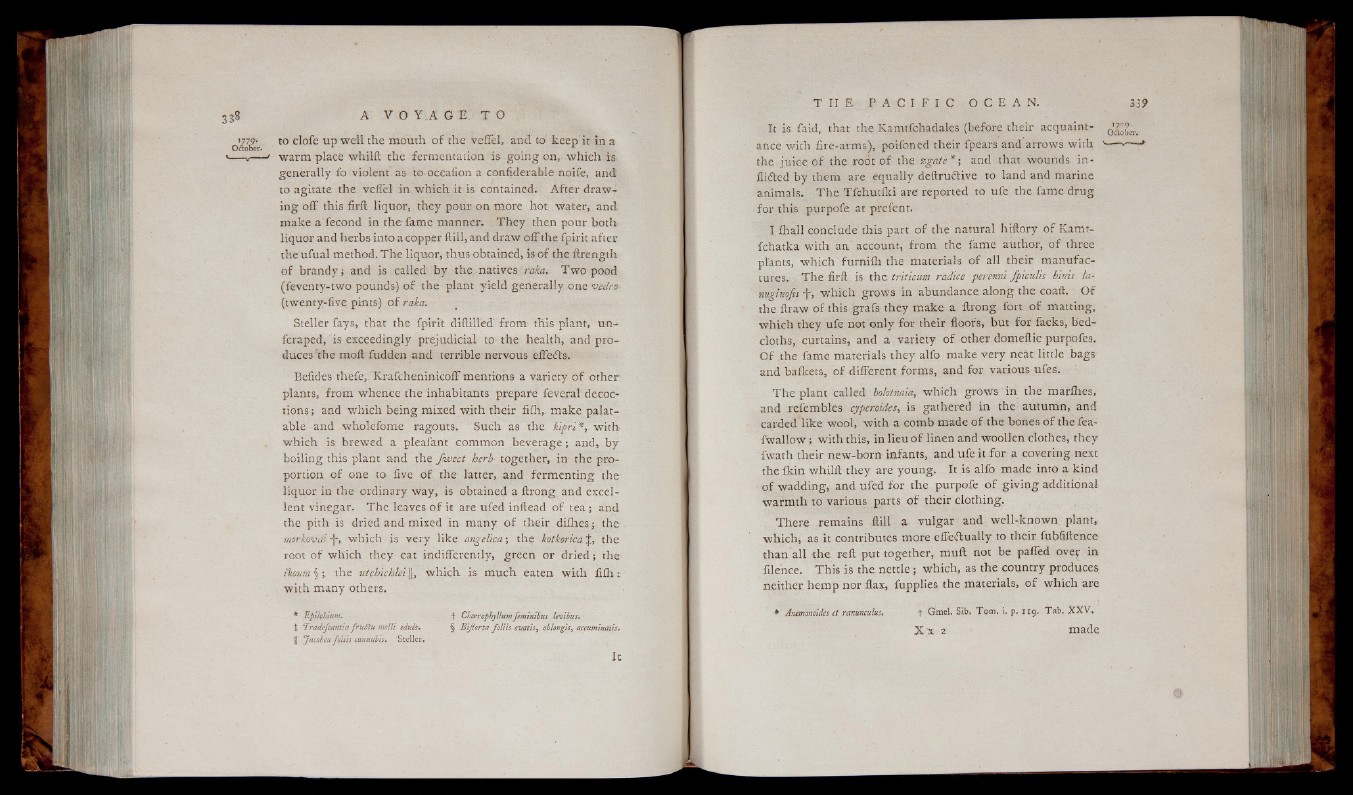
1779- to clofe up well the mouth o f the veiTel, and to keep it in a
Oftober, • t r • • •
— «— J warm place whilft the fermentation is go in g on, which is
generally fo violent as to occafion a confiderable noife, and
to agitate the veiTel in w hich it is contained. Afte r drawin
g o ff this firft liquor, they pour on more hot Water, and
make a fécond in the fame manner. T h e y then pour both
liquor and herbs into a copper ftill, and draw o ff the fpirit after
, the ufual method. T he liquor, thus obtained, is o f the ftrength
o f brandy; and is called by the natives raka. Tw o pood
(feventy-two pounds) o f the plant yield generally one I'edro-
(twenty-five pints) o f raka.
Steller fays, that the fpirit diftilled from this plant, u-n-
feraped, is exceedingly prejudicial to the health, and produces
the moil fudden and terrible nervous effeits.
Befides the fe , Krafcheninkoff mentions a variety o f o th e r
plants, from whence the inhabitants prepare feveral decoctions
; and which being mixed with their fiih, make palatable
and wholefome ragouts. Such as the kipri*, w ith
which is brewed a pleafant eommon beverage ; and, by
boiling this plant and the fw eet herb together, in the proportion
o f one to five o f the latter, and fermenting the
liquor in the ordinary way, is obtained a ftrong and excellent
vinegar. The leaves o f it are ufed inftead o f tea ; and
the pith is dried and mixed in many o f their difhes; the
morkovdi-\r, which is ve ry like angelica; the kotkorica%> the
root o f which they eat indifferently, green or dried ; the
ikoum § ; the utchichlei |[, which is much eaten with fiih :
with many others.
* Epilobium.
t “Tradefcantia fru fiu molli edulo.
I Jacobea foliis cannabis. Steller.
f Chcerophyllum Jemihtbus levibus. ■
§ Bijlorta foliis ovatisy oblongisy accuminatis.
It
It is faid, that the Kamtfchadales (before their acquaintance
with fire-arms), poifoned their fpears and arrows with '
the juice o f the root o f the zgate *; and that wounds in-
flidted by them are equally deftrudtive to land and marine
animals. T h e Tfchutiki are reported to ufe the fame drug
for this purpofe at prefent.
I fhall conclude this part o f the natural hiftory o f Kamt-
fchatka with an. account, from the fame author, o f three .
plants, which furniih the materials o f all their manufactures.
T he firft is the. triticum radice perenni fpiculis binis la-
nuginofts * which grows in abundance along the coaft. O f
the ftraw o f this grafs they make a ftrong fort o f matting,
w hich they ufe not only for their floors, but for facks, bed-
cloths, curtains, and a variety o f other domeftic purpofes.
O f the fame materials they alfo make very neat little bags
and baikets, o f different forms, and for various ufes.
T he plant called bolotnaia, which grows in the marfhes,
and refembles cyperoides, is gathered in the autumn, and
carded lik e wool, w ith a comb made o f the bones o f the fea-
fwallow ; with this, in lieu o f linen and Woollen clothes, they
fwath their new-born infants, and ufe it for a covering next
the ikin whilft they are youn g. It is alfo made into a kind
o f wadding, and ufed for the purpofe o f g iv in g additional
warmth to various parts o f their clothing.
There remains ftill a vu lga r and well-known plant,
which, as it contributes more e fle flu ally to their fubfiftenee
than all the reft put together, muft not be paffed ovef in
filence. This is the nettle ; which, as the country produces:
neither hemp nor flax, fupplies the materials, o f which are
IWK
October»
* Anmonoides et ranunculus\ t Gmel. Sib. T om . i. p. 119 . T a b . X X V .
X t 2 made